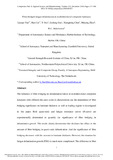JavaScript is disabled for your browser. Some features of this site may not work without it.
| dc.contributor.author | Yao, Liaojun | |
| dc.contributor.author | Cui, Hao | |
| dc.contributor.author | Sun, Yi | |
| dc.contributor.author | Guo, Licheng | |
| dc.contributor.author | Chen, Xiangming | |
| dc.contributor.author | Zhao, Meiying | |
| dc.contributor.author | Alderliesten, R. C. | |
| dc.date.accessioned | 2018-10-10T14:16:09Z | |
| dc.date.available | 2018-10-10T14:16:09Z | |
| dc.date.issued | 2018-09-28 | |
| dc.identifier.citation | Yao L, Cui H, Sun Y, et al., (2018) Fibre-bridged fatigue delamination in multidirectional composite laminates. Composites Part A: Applied Science and Manufacturing, Volume 115, December 2018, pp. 175-186 | en_UK |
| dc.identifier.issn | 1359-835X | |
| dc.identifier.uri | https://doi.org/10.1016/j.compositesa.2018.09.027 | |
| dc.identifier.uri | https://dspace.lib.cranfield.ac.uk/handle/1826/13524 | |
| dc.description.abstract | The influence of fibre bridging on delamination failure in multidirectional composite laminates with different thickness scales is characterized, and the dependence of fibre bridging significance on laminate thickness as well as loading regime is investigated in this paper. Both quasi-static and fatigue resistance curves (R-curve) are experimentally determined to quantify the significance of fibre bridging in delamination growth. The results clearly demonstrate that thickness has effect on the amount of fibre bridging in quasi-static delamination. And the significance of fibre bridging decreases with the increase in laminate thickness. However, the situation for fatigue delamination growth (FDG) is much more complicated. The difference in fibre bridging generation seems to be insignificant in short fatigue cracks and at the plateau state, whereas more bridging fibres can be present in a thinner laminate in-between state. Loading regimes also have significant effect on the amount of fibre bridging. The results clearly demonstrate that more bridging fibres can be generated in quasi-static delamination compared to fatigue. A modified Paris relation proposed by the authors in previous studies is employed in present study to determine fibre-bridged FDG behaviors in multidirectional composite laminates with various thickness scales. All fatigue data locate in a relatively narrow band region of the resistance graph, resulting in a master resistance curve in determining fatigue delamination behaviors. This clearly demonstrates that neither thickness nor fibre bridging has significant effect on fatigue delamination behaviors, if the similarity is well represented. | en_UK |
| dc.language.iso | en | en_UK |
| dc.publisher | Elsevier | en_UK |
| dc.rights | Attribution-NonCommercial-NoDerivatives 4.0 International | * |
| dc.rights.uri | http://creativecommons.org/licenses/by-nc-nd/4.0/ | * |
| dc.subject | B. Fatigue | en_UK |
| dc.subject | B. Delamination | en_UK |
| dc.subject | Multidirectional | en_UK |
| dc.subject | Polymer-matrix composites (PMCs) | en_UK |
| dc.title | Fibre-bridged fatigue delamination in multidirectional composite laminates | en_UK |
| dc.type | Article | en_UK |
| dc.identifier.cris | 21643878 |
Files in this item
The following license files are associated with this item:
This item appears in the following Collection(s)
-
Staff publications (SATM) [4367]

